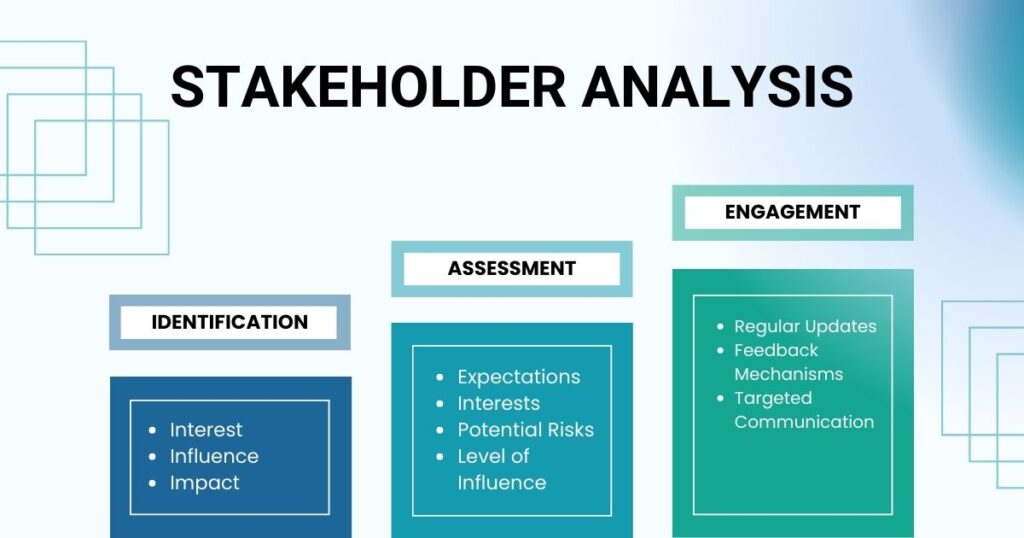
The Essential Guide to Stakeholder Analysis in Digital Transformation Projects
Embarking on an implementation project, whether it involves deploying new software, adopting innovative technologies, or implementing organizational changes, is a multifaceted endeavor that requires strategic planning and meticulous execution. At the heart of a project’s success lies the understanding that it isn’t solely a technical challenge but a collaborative effort involving various individuals and groups with distinct interests and expectations. This is where the significance of stakeholder analysis comes into play.
Stakeholder analysis is a systematic process that involves identifying, assessing, and understanding the diverse individuals and entities impacted by or influencing the implementation project. By recognizing the needs, concerns, and expectations of stakeholders, you can proactively manage relationships, mitigate potential risks, and ensure a more streamlined and successful implementation journey.
Table of Contents
What is a Stakeholder Analysis?
The stakeholder analysis process is a method aimed at comprehensively understanding the various individuals and groups impacted by or influencing a project. It typically involves three main steps: identification, assessment, and engagement.
Firstly, stakeholders are identified by mapping out those who have a vested interest, influence, or impact on the project. Following this, a thorough assessment is conducted to understand each stakeholder’s expectations, interests, potential risks, and level of influence. This step often involves categorizing stakeholders based on their degree of support or opposition to the project. Lastly, the engagement phase focuses on developing tailored communication and engagement strategies to involve stakeholders throughout the project lifecycle. Regular updates, feedback mechanisms, and targeted communication help build positive relationships, manage expectations, and address concerns, ensuring a more collaborative and successful project implementation.
As the project unfolds, the insights gained from stakeholder analysis become integral to decision-making processes, resource allocation, and the development of tailored communication strategies. In essence, stakeholder analysis lays the foundation for a collaborative and inclusive project environment, fostering a sense of shared ownership and commitment among those who will play pivotal roles in the implementation’s success.

Why a Stakeholder Analysis is Crucial for Success
The top five reasons why a stakeholder analysis is key to successful digital transformation are:
- Risk Mitigation:
- Stakeholder analysis helps identify potential risks and challenges early in a project by understanding the concerns, interests, and influences of different stakeholders. This proactive approach enables the project team to develop strategies to mitigate risks and address issues before they escalate.
- Enhanced Communication:
- A stakeholder analysis provides insights into the communication preferences, expectations, and information needs of various stakeholders. This knowledge allows for the development of tailored communication strategies, ensuring that messages are delivered effectively, fostering engagement, and preventing misunderstandings.
- Improved Decision-Making:
- Understanding the perspectives and priorities of key stakeholders contributes to informed decision-making throughout the project. It ensures that decisions align with the broader interests of the organization and its stakeholders, increasing the likelihood of successful outcomes.
- Increased Stakeholder Support:
- Engaging stakeholders early and consistently throughout the project creates a sense of involvement and ownership. When stakeholders feel their input is valued and considered, they are more likely to provide support for the project, reducing resistance and enhancing overall project success.
- Alignment with Organizational Goals:
- Stakeholder analysis helps align the project objectives with the overarching goals and vision of the organization. By understanding the needs and expectations of different stakeholders, the project team can ensure that the implementation aligns with the strategic direction of the organization, fostering long-term success and sustainability.
How is a Stakeholder Analysis Conducted?
Now that we’ve examined why stakeholder analysis is important, let’s look at what steps are typically included as part of the stakeholder analysis process:
- Identification of Stakeholders:
- A comprehensive list of potential stakeholders is created. This usually includes project sponsors, project team members, and any other individuals or groups affected by or influencing the project.
- Stakeholder Mapping:
- Once stakeholders are identified, they are categorized based on their level of influence and interest in the project. This can be done using a power-interest matrix, placing stakeholders in categories like high power/high interest, high power/low interest, low power/high interest, and low power/low interest. This matrix helps prioritize engagement strategies.
- Assessment of Stakeholder Expectations and Concerns:
- Interviews, surveys, or workshops are conducted to gather information on each stakeholder’s expectations, concerns, and interests related to the project. This qualitative data provides valuable insights into the varying perspectives that must be considered throughout the project.
- Analysis of Potential Risks and Opportunities:
- The potential risks associated with each stakeholder are evaluated, considering their level of influence and interest. Challenges are anticipated that may arise from differing expectations or resistance to change. Simultaneously, opportunities for collaboration and mutual benefit are identified.
- Development of Communication Strategies:
- Communication strategies are tailored based on the preferences and needs of different stakeholder groups. Some stakeholders may require detailed technical information, while others may benefit more from high-level summaries.
- Engagement Plans:
- Specific engagement plans for key stakeholders are developed. This may involve regular meetings, progress updates, workshops, or involvement in decision-making processes. Responsibilities for maintaining relationships and managing communication channels with each stakeholder group are assigned.
- Iterative Feedback Loops:
- Mechanisms for ongoing feedback from stakeholders throughout the project lifecycle are established. This can involve surveys, focus groups, or regular check-ins to ensure that stakeholder concerns are continually addressed, and adjustments are made as needed.
By systematically conducting stakeholder analysis using these methods, project teams can gather essential insights to navigate challenges, foster collaboration, and increase the likelihood of project success.

What if I Skip Stakeholder Analysis?
While the benefits listed above are indisputable, people often wonder if they truly outweigh the effort. A common question that arises is, “What happens if we decide to move forward without a stakeholder analysis?” Skipping stakeholder analysis in a project can lead to a cascade of negative effects, jeopardizing the overall success and sustainability of digital transformation.
Firstly, without a thorough understanding of the diverse interests, expectations, and concerns of key stakeholders, there is a heightened risk of encountering resistance and opposition as the project progresses. This lack of stakeholder engagement may result in a project that fails to meet the needs of those it affects, leading to dissatisfaction and decreased support.
Additionally, the absence of a stakeholder analysis diminishes the ability to proactively identify and address potential risks, leaving the project vulnerable to unforeseen challenges. Communication breakdowns and misunderstandings become more likely, hindering the flow of essential information, and impeding collaboration.
Ultimately, skipping stakeholder analysis undermines the foundation for informed decision-making, increases the likelihood of project delays or failures, and can erode the trust and relationships crucial for successful project outcomes.
Harnessing Stakeholder Analysis for Transformational Change
As we’ve explored in this article, a thorough understanding of the diverse interests, expectations, and influences of key stakeholders can become the defining factor for success within a digital transformation. By undertaking a comprehensive stakeholder analysis, organizations lay the groundwork for effective communication, risk mitigation, and strategic decision-making. This process not only fosters collaboration and support but also positions the project for long-term success by aligning it with the broader goals and vision of the organization.
When it comes to digital transformation, where the fusion of technology, culture, and strategy is paramount, stakeholder analysis is a powerful tool that can empower organizations to navigate challenges, seize opportunities, and orchestrate meaningful change. If you want to turn your digital transformation dreams into a sustainable reality for your organization, contact us today. With our Proven Process for Transformational Change, we equip companies to succeed in using technology to bring about change that is positive, permanent, and sustainable. Let’s embark on that journey together.

Transformation is not easy, but it doesn’t have to be impossible. Take control of your project’s success today and schedule a free 30-minute consultation to find out how Victoria Fide can equip you for transformational success.
About the Author
Skylar Stubbs is Project Manager at Victoria Fide and has been leading projects for over 6 years across multiple industries. Skylar is passionate about utilizing technology to enhance work and facilitate more streamlined processes that benefit everyone across an organization. His favorite part of the client journey is being able to help others find better ways to solve business problems and ultimately make lasting, positive organizational change.
